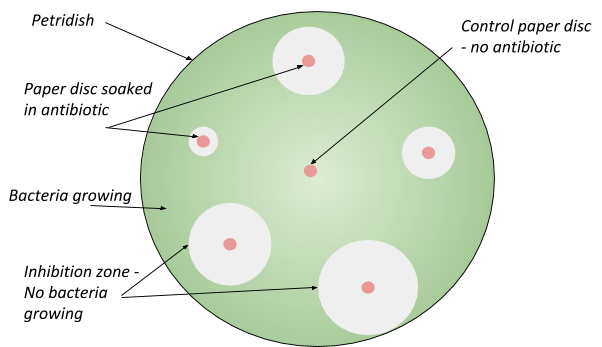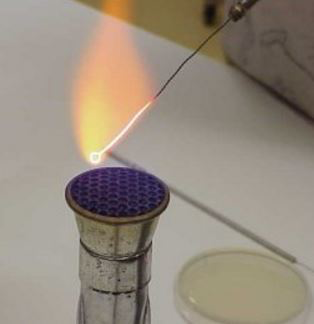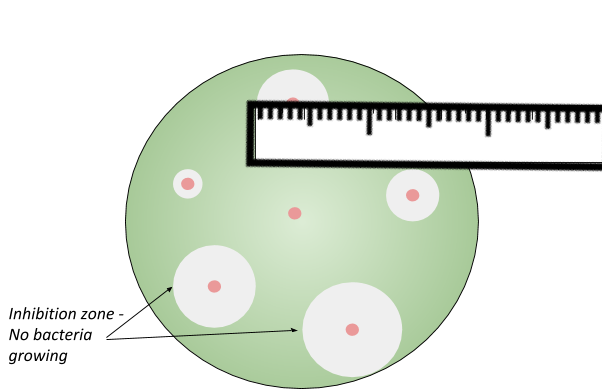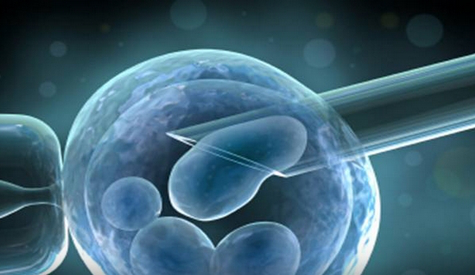Microorganisms
Culturing Microorganisms 1
__You need to know: __
What a microorganism is.
What an antibiotic is.
Understand how to grow bacteria in the lab and test the effectiveness of antibiotics.
Microorganisms __are just what they sound like - small organisms (small living things). The most common type of microorganism you will come across is __bacteria. An antibiotic is something that either kills bacteria or stops them from growing! You’ve probably been prescribed antibiotics before when you’ve been ill. There are lots of different types of bacteria and lots of different antibiotics.
Scientists can grow bacteria in the lab. Very important drugs (like penicillin) were discovered this way. You will need to know how to __culture __(grow) microorganisms in the lab and test antibacterials on them!
__Here is how to do it: __
(Steps 1 and 2 are usually done for you by the lab technician/teacher).
- First, you will need a petri dish filled with solid agar jelly. Solid agar jelly filled with all the ‘food’ that bacteria need to grow (such as carbohydrates, minerals and proteins).
- Place microorganisms onto the agar jelly using a wire loop.
- When bacteria grow on the agar, they will form visible colonies!
- Soak some paper in different types (or concentrations) of antibiotics. Put these pieces of paper spaced apart onto an agar plate, which is evenly covered in bacteria.
- The antibiotics will diffuse throughout the agar jelly. The places where the antibiotics have killed the bacteria will be clear (inhibition zones). This is because the bacteria are non-resistant. Resistant bacteria will continue to grow
- Make sure to place a normal piece of paper (soaked in sterile water) in the centre of the plate, this will act as a control. This makes sure that you know it’s the antibiotics that have killed the bacteria, and not something strange in the paper!
- Leave the plate in a room at 23℃ for 48 hours.
The more effective thew antibiotic, the larger the inhibition zone around the paper.
Culturing Microorganisms 2
You will need to know:
How to perform an uncontaminated culture.
Uncontaminated cultures:
To stop your culture from getting contaminated (pathogens growing when you don’t want them to), you’ll need to do the following:
- Sterilize the petri-dish and incubating loop (if used) by heating them up to a high temperature. This kills any unwanted microorganisms that are already on them.
- After putting the bacteria onto the agar plate, gently tape the lid onto the petri-dish, this stops unwanted microorganisms in the air from getting in.
- Store the petri dish upside down to stop condensation from dripping onto the agar surface.
Measuring Inhibition Zones
You will need to know:
How to measure the area of inhibition zones and compare the effectiveness of antibiotics
The larger the inhibition zone, the more effective the antibiotic is to that particular strain of bacteria. You can usually just see which inhibition zone is the largest, but it’s more reliable and accurate to calculate the __areas __of the inhibition zones and compare them.
To do this you’ll need to:
- Measure the diameter of the zone you’re interested in, with a ruler.
- Half to diameter to get the radius, r.
- Use the equation: Area = πr2 to find the Area. (If you don’t already know from maths lessons, π is just a number that is found on your calculator, it’s usually one of the buttons.)
You can also use this technique to measure the area of colonies. A colony is just a build up of bacteria (like when you leave an old mug out and it goes moldy!)
Stem Cells
You will need to know:
What stem cells are.
The difference between the two types of stem cells.
What are stem cells?
Stem cells are undifferentiated cells (cells that aren’t specialised - see SpecialisedCells for more on specialised cells). They can divide to make many more stem cells, or they can differentiate into specialised cells (depending on what instructions they were given).
There are two types of stem cells:
Embryonic stem cells - Embryonic stem cells are found in human embryos. They are very useful to medical researchers, since they can turn into any type of cell!
Adult stem cells - Adults also have stem cells, but they are only found in a few places, like bone marrow. These are still useful but not nearly as useful as embroyic stem cells, since adult stem cells can only turn into some kinds of specialised cells, like__ red blood cells__.
Stem Cell Research
You will need to be able to:
Understand the differences between adult stem cells and embryonic stem cells.
Debate the pros and cons of embryonic stem cell research.
Adult stem cells in medicine
Adult stem cells can be used to treat some diseases, such as blood diseases. If the patient is cannot produce enough healthy red blood cells, adult stem cells can be injected into the patient. These stem cells can turn into new, healthy red blood cells.
Embryonic stem cells in medicine
Embryonic stem cells are very useful in medicine, since scientists can ‘trick’ the cells into differentiating into lots of different types of cells. They can also be made to have the same genetic information as the patient, using therapeutic cloning. In doing this, it ensures that the new cells won’t be rejected by the patients body!
Issues surrounding stem cell research
Although embryonic stem cell research is proven to be a very useful scientific method and has saved many lives, the stem cells need to be taken from a living embryo.
Arguments for embryonic stem cell research:
- Some people think that existing people who are suffering have more rights than an embryo. They believe that it is better to use this research to save the lives of living patients.
- The embryos which are used are usually taken from abortion clinics, which would most likely be destroyed either way.
- There is lots of research into another way of creating differentiable stem cells, but scientists do not know when this will occur (if it does) and people will continue to die from illness in that time.
Arguments against embryonic stem cell research:
- Other people believe that all life is equal and the rights of the unborn embryo are just as viable as that of the living patient. Therefore they believe that embryonic stem cell research is immoral and wrong.
- People who are against stem cell research are usually against abortion and the destruction of unwanted embryos.
- Some believe that the time and effort put into embryonic stem cell research should be put into trying to find another method of creating differentiable stem cells.



